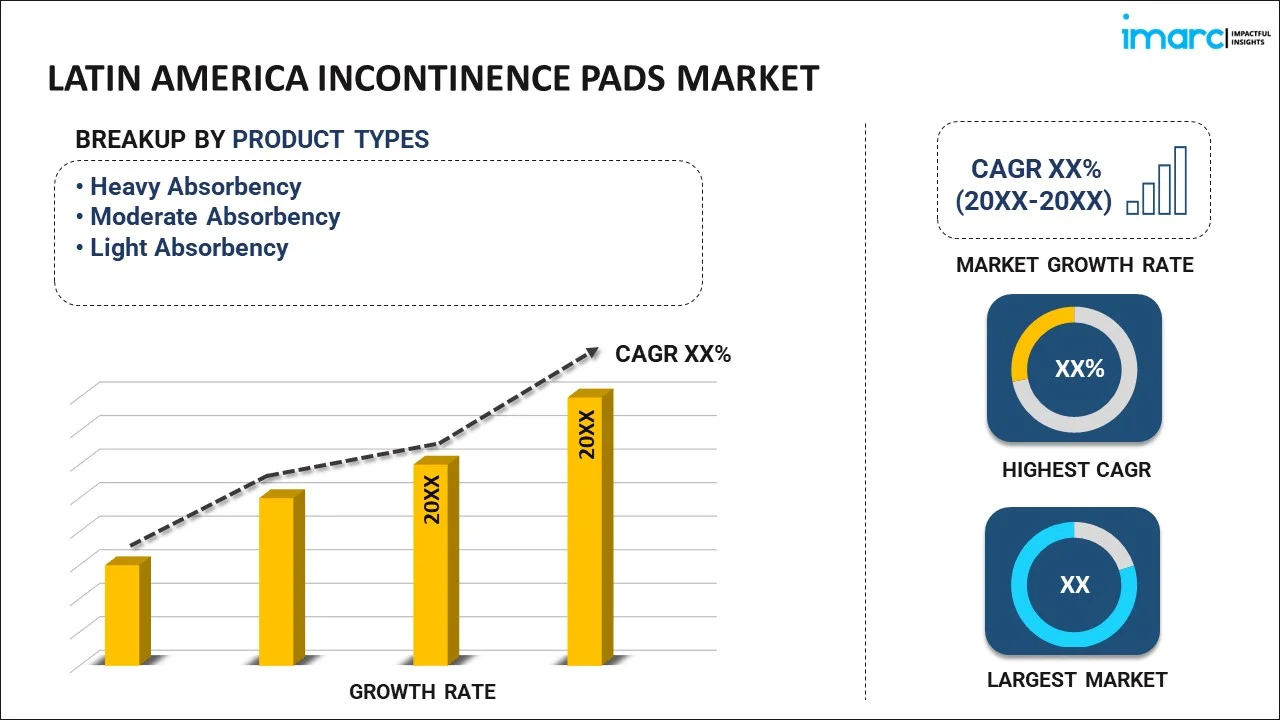
Latin America Incontinence Pads Market Report by Product Type (Heavy Absorbency, Moderate Absorbency, Light Absorbency), Consumer (Women, Men, Unisex), End User (Hospitals, Clinics, Home Care), Distribution Channel (Supermarkets and Hypermarkets, Convenience Stores, Pharmacies, Online Stores, and Others), and Country 2025-2033
Market Overview:
The Latin America incontinence pads market size reached USD 920.0 Million in 2024. Looking forward, IMARC Group expects the market to reach USD 1,550.0 Million by 2033, exhibiting a growth rate (CAGR) of 5.62% during 2025-2033.
|
Report Attribute
|
Key Statistics
|
|---|---|
|
Base Year
|
2024
|
|
Forecast Years
|
2025-2033
|
|
Historical Years
|
2019-2024
|
| Market Size in 2024 | USD 920.0 Million |
| Market Forecast in 2033 | USD 1,550.0 Million |
| Market Growth Rate (2025-2033) | 5.62% |
Incontinence pads include impermeable, multi-layered sheets with high absorbency to control urinary incontinence in adults. They are primarily used by patients who have lost bladder control ranging from the slight release of urine after sneezing, coughing, or laughing to complete urinal incontinence due to dementia, arthritis, diarrhea, mobility impairment, etc. The linings of incontinence pads are made up of polypropylene, polyethylene, sodium polychromate, etc., and are infused with various skin-friendly compounds. These pads prevent soiling of clothes and protect the skin from wetness and rashes. As a result, incontinence pads are widely adopted across hospitals, clinics, and home care-based medical setups.
Latin America Incontinence Pads Market Trends:
In Latin America, the growing prevalence of urinary incontinence conditions, particularly among the geriatric population, is primarily augmenting the demand for incontinence pads. Furthermore, the increasing instances of mobility impairment due to several chronic diseases, such as arthritis, paralysis, sclerosis, brain stroke, etc., are also propelling the market growth. Additionally, the rising hygiene consciousness among consumers coupled with the easy product availability across Latin American countries is further catalyzing the market for incontinence pads. Moreover, the increasing popularity of customized and gender-specific product variants is augmenting the demand for boxer-type diapers and disposable liners for men, and pads and underpants for women. Several government bodies in Latin America are introducing subsidized policies for lowering the high prices of incontinence pads to improve their accessibility across diverse masses. Apart from this, the growing environmental concerns towards waste generation have prompted the need for ecologically-sustainable product variants. Several regional manufacturers are adopting biodegradable and reusable materials for manufacturing incontinence pads, which are further expected to drive the market growth in Latin America over the forecast period.
Key Market Segmentation:
IMARC Group provides an analysis of the key trends in each segment of the Latin America incontinence pads market report, along with forecasts at the regional and country levels from 2025-2033. Our report has categorized the market based on product type, consumer, end user and distribution channel.
Breakup by Product Type:

- Heavy Absorbency
- Moderate Absorbency
- Light Absorbency
Breakup by Consumer:
- Women
- Men
- Unisex
Breakup by End User:
- Hospitals
- Clinics
- Home Care
Breakup by Distribution Channel:
- Supermarkets and Hypermarkets
- Convenience Stores
- Pharmacies
- Online Stores
- Others
Breakup by Country:
- Brazil
- Mexico
- Argentina
- Colombia
- Chile
- Others
Competitive Landscape:
The competitive landscape of the industry has also been examined with some of the key players being Abena A/S, Attends Healthcare Products Inc. (Domtar Corporation), Essity Aktiebolag (publ), Egosan Incontinence, Kimberly-Clark Corporation, Medline Industries Inc., Ontex (Ontex Group), The Procter & Gamble Company and Svenska Cellulosa Aktiebolaget SCA (publ).
Report Coverage:
| Report Features | Details |
|---|---|
| Base Year of the Analysis | 2024 |
| Historical Period | 2019-2024 |
| Forecast Period | 2025-2033 |
| Units | Million USD |
| Segment Coverage | Product Type, Consumer, End User, Distribution Channel, Country |
| Countries Covered | Brazil, Mexico, Argentina, Colombia, Chile, Others |
| Companies Covered | Abena A/S, Attends Healthcare Products Inc. (Domtar Corporation), Essity Aktiebolag (publ), Egosan Incontinence, Kimberly-Clark Corporation, Medline Industries Inc., Ontex (Ontex Group), The Procter & Gamble Company and Svenska Cellulosa Aktiebolaget SCA (publ) |
| Customization Scope | 10% Free Customization |
| Post-Sale Analyst Support | 10-12 Weeks |
| Delivery Format | PDF and Excel through Email (We can also provide the editable version of the report in PPT/Word format on special request) |
Key Questions Answered in This Report:
- How has the Latin America incontinence pads market performed so far and how will it perform in the coming years?
- What has been the impact of COVID-19 on the Latin America incontinence pads market?
- What are the key regional markets?
- What is the breakup of the market based on the product type?
- What is the breakup of the market based on the consumer?
- What is the breakup of the market based on the end user?
- What is the breakup of the market based on the distribution channel?
- What are the various stages in the value chain of the industry?
- What are the key driving factors and challenges in the industry?
- What is the structure of the Latin America incontinence pads market and who are the key players?
- What is the degree of competition in the industry?
Need more help?
- Speak to our experienced analysts for insights on the current market scenarios.
- Include additional segments and countries to customize the report as per your requirement.
- Gain an unparalleled competitive advantage in your domain by understanding how to utilize the report and positively impacting your operations and revenue.
- For further assistance, please connect with our analysts.
 Inquire Before Buying
Inquire Before Buying
 Speak to an Analyst
Speak to an Analyst
 Request Brochure
Request Brochure
 Request Customization
Request Customization




.webp)




.webp)












